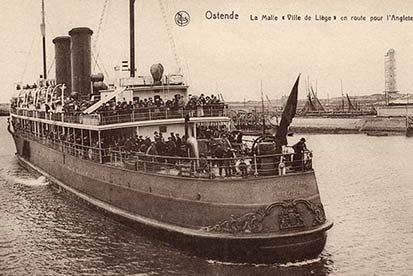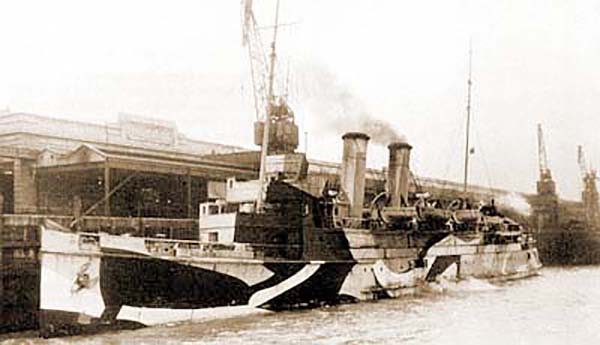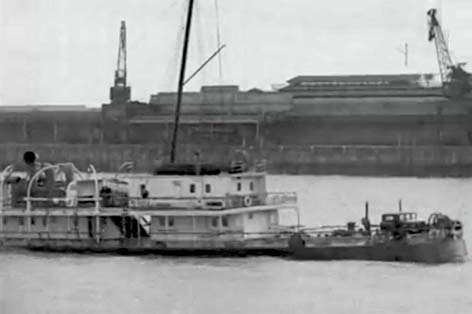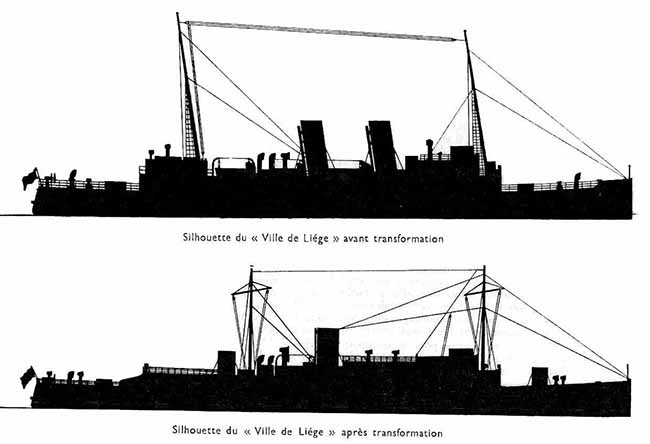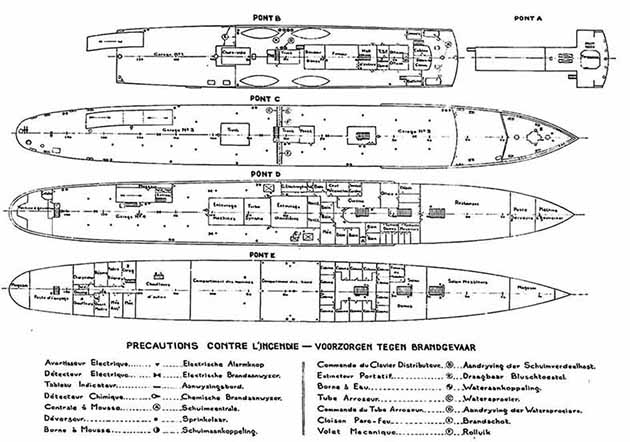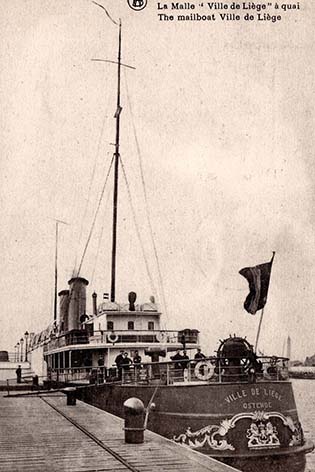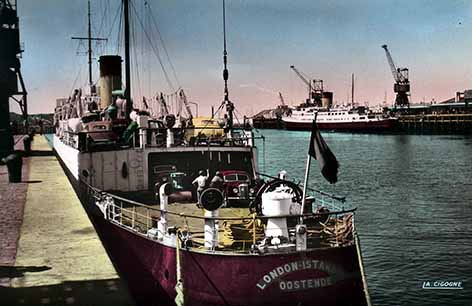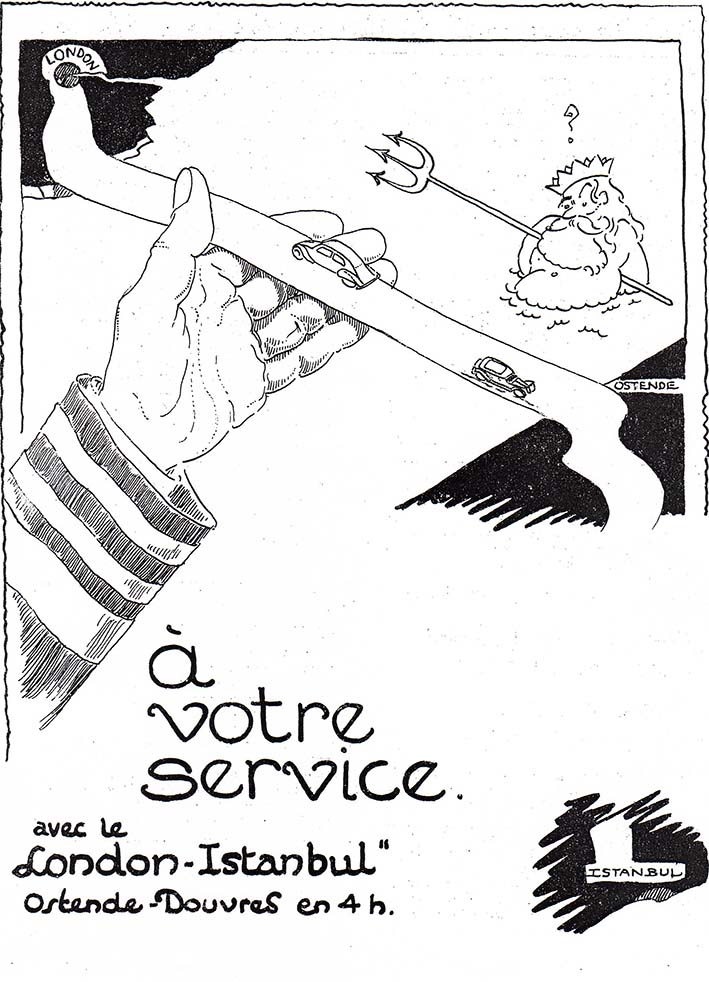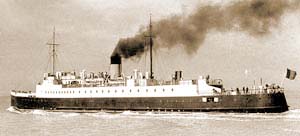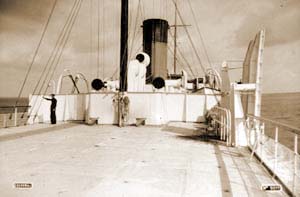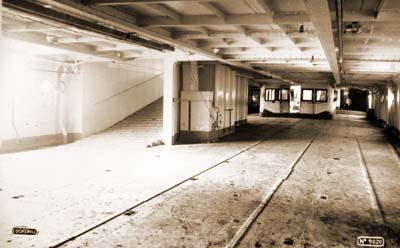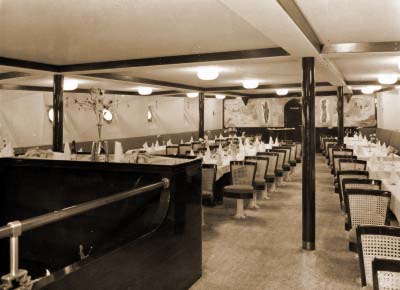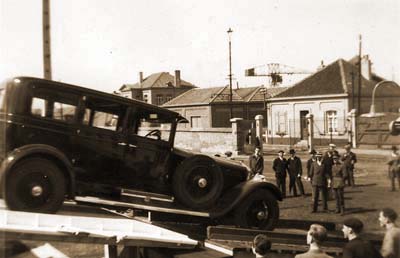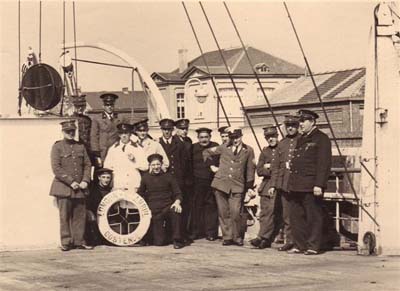Het was 3 september 1911 wanneer al het krediet van 2.5 miljoen voor de bouw van 2 nieuwe schepen werden goedgekeurd. De lancering zou in 1913 plaats hebben bij de viering van de honderdste verjaardag van Hendrik Conciense en de internationale tentoonstelling te Gent. Er werd nogal gespeculeerd over de namen. Consience, Artevelde of Baron Lambertmont werden aanvankelijk op tafel gegooid.
Tegen de tijd dat er in 1913 een bouwwerk op de slede stond en bij Cockerill plannen gemaakt voor de lancering, was men het eens over de naam “Ville de Liège”. Het schip zou op 31 mei 1913 te water worden gelaten onder het meterschap van mevrouw Seghers. Ongelukkig brak rond die tijd een staking uit en diende de lancering twee weken uitgesteld tot 14 juni.
In aanwezigheid van de Minister van Verkeerswezen Seghers en zijn dame, die enkel minuten na 11u00 het touw doorhakte, gleed het schip statig in het water. De meter kreeg de sierlijk bijl en een grote bloemenkorf als aandenken cadeau. Tegen twaalf uur konden de genodigden aan tafel aan boord van de nog in afwerking Stad Antwerpen en werden de nodige toespraken gehouden.
Dhr. Pierrard, toenmalig directeur generaal Zeewezen, was vol lof over de realisatie van de nieuwe vaartuigen en bracht de nieuwe innovatie van de voorziene Frahm anti-slingertanks fier ter aandacht. Het interieur was precies zoals de Stad Antwerpen afgewerkt.
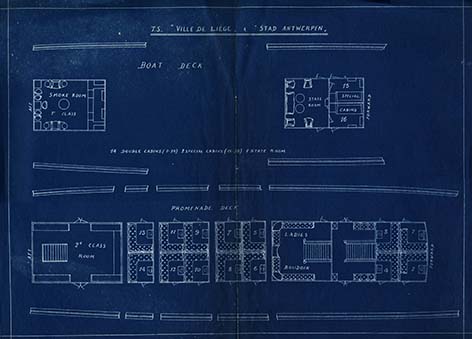
De schepen waren speciaal gebouwd om dienst te doen in de wintermaanden. Om die reden waren ze ook kleiner in afmetingen dan de andere turbineschepen. De Ville de Liège was 95.40 m. lang en 11.79 m breed met een diepgang van 3 meter. De aandacht was ook gevestigd op de constructie van de bovenbouw. Dit alles moest de stormachtige omstandigheden van de wintermaanden trotseren en vooral zekerheid en stiptheid van de dienst garanderen. Veel aandacht ging uiteraard ook naar de anti-slingertanks. De problemen die met de Stad Antwerpen ervaren moesten ten alle koste vermeden worden met de Ville de Liège. Het was dan ook pas zes maanden later na de lancering dat de eerste proeven met de Ville de Liège werden uitgevoerd. Op 24 december 1913 mocht kapitein Rohart om 08u00 met een stevige N-O wind de proeven uitvoeren met aan boord een commissie van Zeewezen en leden van Cockerill. Het schip gedroeg zich voorbeeldig inzake stabiliteit en haalde met gemak een snelheid van 24 knopen. Omstreeks 15u00 waren ze tevreden terug. The anti-roltanks waren beter voor de stookplaats geplaatst en de Ville de Liège bleek beter resultaten te halen dan de Stad Antwerpen.
Op 14 januari 1914 kon de Ville de Liège dan in dienst genomen met vertrek te Oostende om 10u47 en terug Dover om 16u15. Op 28 januari en dus pas twee weken na de maidentrip had de Ville de Liège enige tijd na vertrek te Dover om 16u15 met cdt. Rohart in de oversteek en in de mist een aanvaring met de kolenschip de Counfield uit Newcastle. Een hevige schok op volle zee in de dichte mist veroorzaakte nogal paniek onder de reizigers. De Counfield zette na de aanvaring zijn weg gewoon verder naar Bordeaux ondanks de lichte schade. De Ville de Liège had het achterschip geraakt. De kapitein en de bemanning konden echter de reizigers gerust stellen en na onderzoek van de schade kon het schip nog de reis naar Oostende verder zetten. Weliswaar met vertraging om omstreeks 22u00 in Oostende aan te komen. Gelukkig had de bemanning van de Ville de Liège het schip aangevaren herkend. De boeg en het roer van de Ville de Liège waren niet buiten dienst maar het schip moest toch naar het droogdok gezonden voor onderzoek door experten. Op 6 februari kon de Ville de Liège in de droogdok Antwerpen voor inspectie en herstel. Na een week was het schip hersteld en terug uit het droogdok.
Op 15 maart bleek de zee sterker dan ingenieurs hadden voorzien. Na vertrek uit Oostende om 10u47 had de Ville de Liège een sterke Z.W. wind te verduren. Tegen aankomst in Dover hadden de wilde golven al een gedeelte van de onder brug weggeslagen.
WW1
De zomer zou geen zomer worden zoals verwacht. Vanaf 1 augustus werd uit veiligheid de Ville de Liège in de achterhaven aan het kanaal Oostende-Brugge gelegd. De Oostende-Dover lijn beschikte inmiddels al over vijf turbine schepen. Men wilde in geen geval dat deze snelle vaartuigen in Duitse handen zouden vallen. Klaar aan het kanaal Oostende-Brugge kon den de schepen bij onheil snel vluchten naar Brugge of Zeebrugge. In die eerste weken van augustus organiseerde het Zeewezen afvaarten uit Antwerpen naar Oostende vanaf de Jordaankaai. Volwassenen betaalden 10 Fr. en kinderen onder de twaalf jaar 5 Fr. Tussenin werden tevens ook afvaarten naar Folkestone uitgevoerd. Dit overwegend met de paddelstomers. De haven van Dover was immers gesloten voor commercieel trafiek. Maar de haven van Folkestone werd overrompeld door de vele kanaallijnen die niet meer naar Dover konden en dus Folkestone moesten aandoen. Er werden in Oostende afvaarten geschrapt. Er was eind augustus nog één afvaart om 10u47 per dag. Op 21/8 werd de Ville de Liège naar Antwerpen gestuurd na voorheen verschillende afvaarten naar Folkestone te hebben gedaan.
> Op 7 oktober 1914 brengt ze een deel van de ambtenaren van de overheid en vluchtelingen uit Antwerpen naar Oostende en neemt deel aan de evacuatie van Oostende naar Engeland en Frankrijk.
> Op 17 oktober 1914 is de Ville de Liège in Calais, word omgevormd tot hospitaalschip en blijft daar gestationeerd.
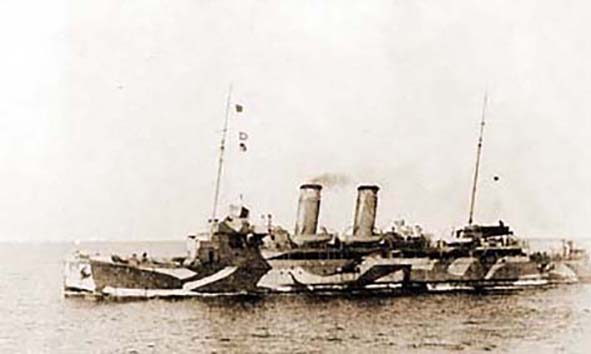
De Ville de Liège tijdens de eerste Wereldoorlog 14-18.
> In mei 1917 word het schip aan Engeland uitgeleend en herschikt als hospitaalschip in Dover. Vanaf 21.6.17 tot 31.12.18 was de Ville de Liège in gebruik en volbracht ze als hospitaalschip 252 reizen.
Op zaterdag 18 januari 1919 was het de Ville de Liège met commandant Rohart en 1lt Aspeslagh die de eerste maal uit Dover naar Oostende met 366 reizigers mocht vertrekken waaronder de eerste terugkerende vluchtelingen uit Engeland. De mensen aan boord waren de vrijdagnacht om 02u00 uit Londen vertrokken naar Dover. Ze mochten tot 06u00 op de trein blijven tot ze op de Ville de Liège mochten inschepen.
Elke reiziger kreeg een geschenk als aandenken voor hun verblijf in Engeland mede een hartelijk afscheid na de vier jaren steun en vriendschap. Het schip kon uit Dover om 09u00 vertrekken en stak regelrecht over richting Calais om dan verder langs de kust naar Oostende te varen. Onderweg kwamen ze nog drie Engelse mijnvegers tegen, een Nederlandse stomer en twee Oostendse sloepen. De bemanningen juichten van geluk en begroetten de reizigers aan boord van de Ville de Liège uitbundig.
Gans Oostende stond op de kaai en pier om het schip te verwelkomen. Wat had men die maalboten vier jaar lang gemist. Omstreeks 11u30 kon men in de verte al de Ville de Liège zien. Het schip zwaaide voor de rede en voer de haven binnen begeleid door een grote sleepboot. Bij het zien van het schip dat juist voorbij het wrak van de Flandre voer begonnen veel mensen te wenen. Al wie kon begon naar de aanlegkaai te lopen. De muziekkapel van de 23e linie speelde de Brabaconne, de soldaten presenteerden het geweer, het volk juichte en zwaaide met alles wat het maar in handen kreeg naar de Ville de Liège en haar reizigers.
Eenmaal aangelegd stapte de Minister Jaspar en stadsbestuur aan boord van het schip en toen het lawaai van de menigte wat bedaarde kon de Minister in naam van de regering de vluchtelingen welkom heten in hun vaderland.
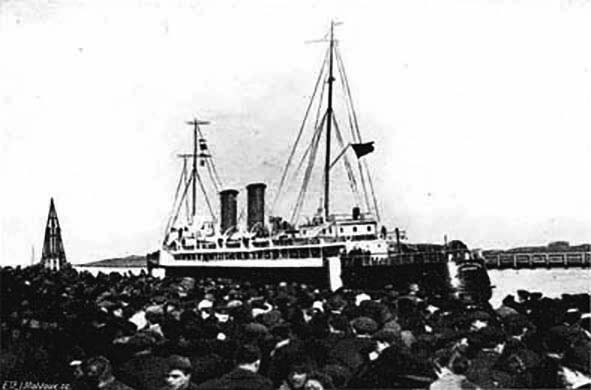
Eerste aankomst te Oostende op 18 januari 1919. Merk de massa volk op de kaai.
De volgende dagen kon de Ville de Liège verder vluchtelingen uit Dover naar hun thuisland brengen. Aankomen was wel enkel mogelijk wanneer er voldoen getijde stond want in de havengeul lagen nogal wat wrakken. De gekendste was uiteraard de HMS Vindictive met ernaast de eigen maalboot Flandre. Deze laatste was nog door de Duitsers in de geul tot zinken gebracht bij hun vertrek.
De Ville de Liège werd zelfs eind januari 1919 nog bij het uitvaren verrast door de stroom en tegen een gezonken baggerboot gegooid aan de ingang van de haven. Een sleepboot en een Engelse motorboot snelden snel ter hulp maar gelukkig was er geen schade en kon de Ville de Liège met een kwartier vertraging de reis naar Dover verder zetten.
De schade in de haven was enorm. Het herstel om de haven en installaties terug operationeel te maken nam dan ook heel wat tijd in beslag. In de eerste maanden van 1919 waren het de Ville de Liège en Stad Antwerpen die regelmatig de overtocht deden. Dat was meestal de maandag rond de middag, de woensdag rond 13u30 en de zaterdag rond 18u30. De afvaart kon pas met geschikt getijde en de overtocht duurde gemiddeld 3 ½ uur. Men wachtte op de Pieter de Coninck zodat een dagelijkse afvaart kon doorgaan Het Zeewezen had ook al vanaf februari de tarieven voor een overtocht verdubbeld. Een overtocht per enkele reis kostte voor 1e klasse : 20.60 Fr. en voor 2e klasse: 11.25 Fr.
In juni van dat jaar brak er dan nog een staking uit onder het varend personeel. De Belgen wilden gelijk betaald als de Engelsen voor hetzelfde werk. Begin augustus had men al zes vaartuigen terug die de diensten konden verzekeren. Op 1 augustus werden zelfs records gebroken met het aantal reizigers op één dag. De Princesse Marie José bracht 1087 + 1100 pax– de Pieter de Coninck 1193 pax – de Jan Breydel 1237 pax – Ville de Liège 691 + 1090 pax en Stad Antwerpen 727 pax. De Princesse Marie José en de Ville de Liège hadden die dag de overtocht twee maal gedaan om het grote totaal aantal van 8227 reizigers uit Dover naar Oostende te brengen. Het duurde toch nog de rest van het jaar om tot normale diensten en regelingen te komen. Zo werd pas het wrak van de HMS Vindictive in augustus 1920 weggehaald.
Het Zeewezen was ook gestart met de mogelijkheid om auto’s mee te nemen. Om dit mogelijk te maken kocht ze laadplateaus waarmee de auto veilig met een kraan op het achterdek kon gezet. Zo kon men maximum een tiental auto’s laden. Ook had men dekzeilen aangekocht om de auto’s tijdens de overtocht te beschermen voor het water.
De Ville de Liège had de eer in 1920 om belangrijke personaliteiten te vervoeren uit Dover naar Oostende. Zo kwam Maarschalk French op 19 mei 1920 naar Oostende op de Ville de Liège waarbij het schip met militaire eer begroet werd door 21 kanonschoten en de muziekkapel van de 23e linie het Engels nationaal lied speelde. De haveninstallaties waren rijkelijk bevlagd. De maarschalk begaf zich naar Ieper en werd zelfs door luitenant generaal Jungbluth vergezeld alsook een speciale trein ter beschikking gesteld. Ook Koning Albert kwam de belangrijke Maarschalk begroeten.
In juni van 1921 mocht de Ville de Liège nog eens een heel belangrijk persoon escorteren. Op dinsdag 14 juni mocht de Ville de Liège met Prins Hiro Hito de installatie van de Antwerpse haven gaan bezoeken.
Zelfs in 1922 was de zee nog niet zonder gevaar. In de laatste week van november 1922 zag de Ville de Liège op zo’n zes mijl van de Ruytingen plots een troep meeuwen opvliegen. Ze bleken daar op een mijn te hebben gezeten. Gelukkig werd dit hierdoor tijdig gezien en konden de instanties worden verwittigd.
Op zondag 14 juni 1925 had de Ville de Liège bij het aanleggen in Dover aan de admiralty pier een aanvaring met de Biarritz van de South Eastern Railway. Het was deze laatste die wat averij opliep.
In mei 1926 verloor de Ville de Liège in de haven van Dover zijn anker met ketting.
In juli van 1927 kon men zelfs aan verminderde prijs mee met de Ville de Liège voor een uitstap naar Londen voor de wedrennen van Goodwood.
In februari 1928 ging de Ville de Liège naar het droogdok in Gent. Bij het verlaten en versassen in Gent botste de Ville de Liège en zijn sleepboot tegen de kaaimuur waarbij zowel het schip als de kade werd beschadigd.
Begin 1929 had men nog een en ander op de Ville de Liège veranderd. Er werd een luxehut en twee speciale hutten op het opperdek achter deze van de commandant ingericht. Gans het achterdek werd voorbehouden voor 2e klasse en afgezonderd van de 1e klasse. Daar waren er geen veranderingen. De verbeteringen waren voornamelijk voor de 2e klasse.
De maandagavond van 11 februari van dat jaar ging het ernstig mis. Bij het binnenvaren van Dover met extreem laag tij liep de Ville de Liège aan de grond naast de pier in de haven en zonk op de bodem. De Ville de Liège wilde de haven binnen gaan richting aanlegpost met een stevige wind en zeer laag water. Toen het maneuver bleek te mislukken sloeg het schip achteruit en de wind en de wilde zee joeg het schip parallel buiten de haven met de oever op de rotsen. De reizigers stonden al op dek en vielen neer door de hevige schok. Er werd onmiddellijk een vuurpijl afgeschoten om hulp te vragen. Daarop snelden sleepboten van Dover zich haastig naar de Ville de Liège maar werden belemmerd door de lage waterstand om dichtbij het schip te komen. Het was bar koud weer met een harde gure oostenwind. Het schip had 48 reizigers aan boord die een reddingsgordel moesten aandoen. Ondertussen liep het water binnen langs de machinekamer door schade opgelopen onder de waterlijn en viel enkele minuten later de hulpmachine uit en lag het schip in totale duisternis. Twee sleepboten slaagden erin om dichterbij te komen en aan de Ville de Liège vast te maken zodat aan de evacuatie van de 48 reiziger kon begonnen om deze te Dover omstreeks 21u30 aan de wal te brengen. Men kon reddingssloepen te water laten en samen met de hulpbootjes van Dover de reizigers veilig aan wal brengen. De reizigers waren vervroren van de kou. Anderhalf uur hebben de sleepboten gepoogd het schip nog te enkele meters te verslepen maar deze begon steeds dieper te zinken. Om 22u30 gaf de commandant Bly bevel aan de bemanning om te ontschepen en lag de pakketboot gevaarlijk hellend over stuurboord in totale duisternis. Na de volledige evacuatie ging de commandant met zijn luitenants nog even voor 23u00 terug naar het schip om een tros vast te maken. Ze hadden maar een paar minuten de tijd en de Ville de Liège zonk volledig plat op de bodem. Men kon de volgende dag nog wel de postzakken en bagage van het schip halen bij laag water.
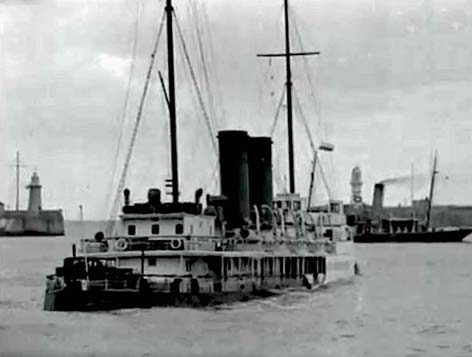
11 februari 1929 - De Ville de Liège gezonken in Dover.
In eerste instantie werd een onderzoek gestart om de schade aan het schip na te gaan. Duikers hadden verschillende openingen in de huid vastgesteld door het raken van de rotsen. Met de medewerking van Dover kon men 10 dagen later het schip in beweging krijgen. Men had een ponton van de Admiraliteit laten overkomen uit Portsmouth. Na de openingen in de lek geslagen compartimenten min of meer te hebben gedicht legde men aan beide zijden een sleepboot die de volgelopen compartimenten uitpompten. Een grote sleepboot kon het schip bij hoog water en wanneer er beweging in kwam meer naar de binnenhaven verslepen. Daar kon men de eerste werken doen om het schip klaar te maken om deze naar een haven te kunnen verplaatsen voor herstelling. Op 6 maart kon men de Ville de Liège naar Calais in een droogdok brengen. De schade was aanzienlijk. De bodem was ernstig beschadigd door over de rotsen te lopen. De huidplaten waren gedeukt en zelfs gescheurd op plaatsen. Alsook de schroeven zwaar verminkt. De onlangs prachtig ingerichte hutten waren erbarmelijk om aan te zien. In Calais kon men het nodige doen om het schip voldoen vlot te houden om deze naar de werf te kunnen verplaatsen. Op 17 maart kwam de Ville de Liège in Hoboken aan om door Cockerill volledig te worden hersteld. De herstellingen zouden maanden gaan duren en de kosten werden geraamd op anderhalf miljoen frank.
Op 11 april werden de machinisten van de Ville de Liège in het Zeestation van Oostende door de Minister Lippens gehuldigd en gedecoreerd voor hun heldhaftige houding bij het ongeval. Dat deed wat wrevel ontstaan omdat de dekbemanning geen aandacht kreeg. Nochtans kreeg de ganse bemanning van de Ville de Liège in de Dover kranten alle eer en lof voor hun koelbloedige optreden en heldhaftigheid bij het ongeval.
Achteraf kreeg de beheerder Southern Railways van Dover Haven de kritiek dat het ongeval kon vermeden worden. De Ville de Liège was door de havenautoriteit naar post 1 gestuurd. Door de extreem lage waterstand stond deze a.h.w. droog. Terwijl post 2 en 3 vrij was. De rekening achteraf gemaakt bedroeg 5 miljoen voor de herstellingen en 350 000 Fr voor het terug vlot brengen. Einde september 1929 kwam de Ville de Liège hersteld terug naar Oostende om zijn diensten te kunnen hervatten. Hopelijk zonder ongevallen.
Ondertussen waren de nieuw bestelde turbine schepen in aantocht. De Ville de Liège was ondertussen al 15 jaar. Eind 1930 wijzigde het Zeewezen het schip om als opleidingsschip te dienen voor de nieuwe zeevaartschool. Men dacht in eerste instantie eraan het schip te verkopen.
In februari 1936 besliste men dan om de Ville de Liège om te bouwen voor transport van auto’s. De Belgische lijn moest immers de reputatie als voornaamste lijn op het kanaal kunnen behouden. Op woensdag 26 februari vertrok de Ville de Liège met commandant Timmermans en Lt Van Waesberg naar Hoboken Antwerpen voor de ingrijpende ombouw . Het schip zou worden aangepast om 60 a 70 auto’s te kunnen laden op drie dekken. Er zouden 50 hutten voor chauffeurs en 150 voor 1e klasse. De overtochten zouden immers meestal ‘s nachts doorgaan waardoor de reizigers een comfortabele reis konden maken. Op vlak van brandveiligheid werd aandacht geschonken om zoveel als mogelijk brandveilig materiaal te gebruiken. Ook werd een schuim blussysteem voorzien in de garageruimten. De Ville de Liège zou een snelheid van 20 knopen halen. Om het schip te voorzien van dieselmotoren werd afgezien omdat het schip te licht gebouwd was. Men diende deze op mazout te voorzien. De schouwen werden vervangen door één nieuwe schouw. Omdat het schip nog niet zo lang na het ongeval in Dover volledig was hersteld en van nieuwe huidplaten was voorzien en het schip geschikt voor het doel en was deze omvorm verantwoord. Toch hing er een prijskaartje aan van zo’n 10 miljoen frank. Dit alles in een beperkte tijdspanne om het schip nog voor het zomerseizoen in dienst te kunnen stellen.
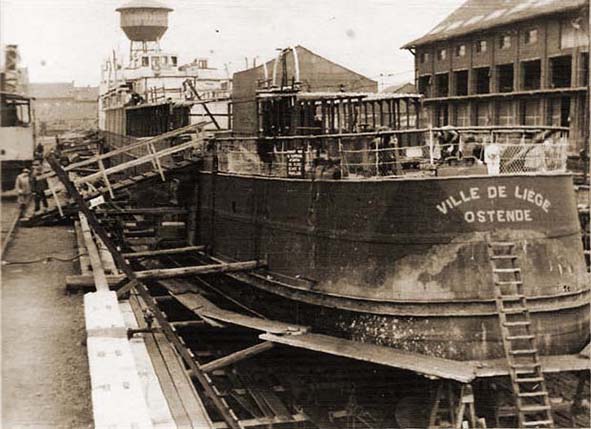
1936 > Ombouw Ville de Liège bij Cockerill naar car-ferry.
Terwijl de werken aan de gang waren voor de Ville de Liège komt Koning Léopold III op 31 maart de eerste klinknagel van de Prins Albert zetten en bracht ook een bezoek aan de Ville de Liège. Op zaterdag 25 juli kwam de Ville de Liège afgewerkt van Antwerpen met heel wat vooraanstaanden naar Oostende en had de nieuwe naam “London Istanbul” gekregen. Voor proef deed ze een reis naar Oostende en dan naar Dover. Het schip moest om 08u00 vertrekken uit Antwerpen maar men heeft een tijdje gewacht op de minister. Deze stuurde wat later een bericht dat hij verhinderd was. Commandant Aspeslagh vertrok om 09u00 en kwam even na de middag aan in Oostende.
Op 30 juli 36 kon de London Istanbul haar Maiden-Trip maken ditmaal met de minister Jaspar aan boord. Ze vertrok even na negen uur en diende voor Westende even een half uur stil te houden wegens een technisch machine defectje en liep verder langs de binnen-route en Belgische kust. Het weer zat mee met een licht briesje uit het noorden. Om 13u00 in Dover aan te komen. Even later om 14u00 werden de Engelse genodigden aan boord verwacht van de nieuwe autocarrier met de nodige toespraken en receptie. Er worden uiteraard nog 12 Engelse auto’s aan boord genomen. De terugvaart was voorzien om 16u30 om dan omstreeks 20u30 te Oostende aan de oosteroever aan te komen.
De naam London Istanbul is niet zomaar lukraak gekozen. De verbouwing was gekoppeld aan het internationale project dat een autostrade Londen naar Istanbul ging voorzien door Europa in de komende jaren. In feite werd “the gateway to Europe” dat per openbaar vervoer mogelijk was nu ook voorzien om beter voertuigen te behandelen. Het Zeewezen had hierin een belangrijke beslissing en uiteraard investering gedaan. Ware het niet dat het schip op de oosteroever werd geladen. De weg daar naartoe was niet in goede staat en liep via de jachtclub, tram en treinsporen. Men probeerde nog de weg te verbeteren maar dat leidde niet tot tevredenheid. Het was wenselijk om ook aan de west kaai over de mogelijkheid te beschikken om de auto’s op de London Istanbul in te schepen. Vandaar de plannen voor de bouw van een terminal of beter gezegd de dan toekomstige “Istanbul terminal” of car-ferry terminal. Dat eerste jaar was een schot in de roos. Het aantal reizigers ging die zomer met meer dan 30 % de hoogte in. In de maand augustus bracht men 200 884 reizigers over het kanaal. In totaal telde men die maand 3488 voertuigen waarvan 1565 voor rekening van de London-Istanbul alleen.
In de nazomer van 22 tot 26 september 1936 bracht de London-Istanbul een vijfdaags bezoek aan de Brussel en lag in het Vergote dok afgemeerd. Voor de gelegenheid werd een reis georganiseerd van Brussel naar Antwerpen met auto’s. De zaterdag 24 was er een galabal aan boord met twee dansvloeren, twee orkesten en vele vooraanstaande personaliteiten uit diverse landen. De zondag was er zelfs een Bridge en een The-dansant aan boord voor liefdadigheidsdoel. De ombouw kon duidelijk nog voor een ander doeleind gebruikt worden en was een belangrijk PR middel voor de lijn. Het schip mocht op vele gelegenheden in België aanwezig zijn.
Begin 1938 werden er kleine wijzigingen aan de London-Istanbul gedaan. Er werden vier hutten ingericht in plaats van badkamers. Voor de reizigers werd een afdak voorzien dat schaduw bracht. Men hoopte dat dit het laatste seizoen was dat het schip aan de oosteroever zou moeten aanleggen. Voor 1939 had men 17.5 miljoen havenwerken voorzien waaronder een stuk om post 1 en 2 aan het Zeestation westeroever te vernieuwen en de kaai aan te passen voor de London-Istanbul. Men hoopte inmiddels om tegen het seizoen 1939 de nieuwe car-ferry terminal in dienst te kunnen nemen. De gebeurtenissen in de wereld bepaalden daar anders over.
WW2
In oktober 1939 werd de haven van Dover gesloten voor commercieel trafiek en moesten de schepen naar Folkestone. Dat duurde tot 16.5.1940 tot wanneer de schepen België moesten verlaten.
> De London-Istanbul vertrok op 17 mei 1940 met vluchtelingen naar Folkestone en gaat de volgende dag naar Southampton.
> Op 29.6.1940 word de London-Istanbul overgedragen aan het Ministry of War en ligt in Southampton.
> Op 30 september vertrekt ze naar Dartmouth.
> In november 1940 verlaat ze Dartmouth en gaat naar Holyhead. Op 6.11.40 valt ze in het kanaal zonder mazout en gaat voor anker. Ze word later naar Milford gesleept.
> Op 11.11.40 komt ze in Holyhead in aanvaring met een cargoschip de Santiago en blijft in Holyhead liggen tot 13.9.1941.
> Op 14.9.1941 word de London-Istanbul overgedragen aan de Royal Navy en vertrek naar Glasgow om te worden omgevormd bij de werf Barclay Curbe werf tot magazijnschip voor mijnvegers. Ze krijgt de nieuwe naam “ HMS ALGOMA”.
> In november 41 en na voltooiing word het schip opnieuw hernoemd als “H.M.S. AMBITIOUS”.
> Op 16.1.1942 plaatst de Royal Navy het schip in Greenock en bleef daar tot in december 42.
> Op 7.2.1942 vertrekt de Ambitious uit Greenock naar Scapa Flow om vanaf 11.2 als depot schip voor de mijnvegers te fungeren tot in december 42.
> Op 29.12.1942 word ze in de Humber omgevormd als comfortabel accommodatie en recreatieschip voor de manschappen van mijnveegdienst in Ijsland. Het personeel van de mijnveegdienst kon de kleine werkruimtes verlaten om te gaan uitrusten op de HMS Ambitious. Voor dit doel werd het schip voorzien van een cinema, badruimtes, salons, bibliotheek en een grote kantine. Het vroegere restaurant en rookzaal werd voor de officieren voorbehouden. Aan boord bevonden zich een groot aantal geneesheren en tandartsen die voor de gezondheid van de manschappen instonden. Er was dus ook een ziekenboeg en operatiezaal aan boord.
> Op 29 augustus 1943 vertrekt ze naar Scapa Flow maar krijgt kort na afvaart averij en gaat 10.9.1943 naar Rosyth voor herstellingen. Tegen 9.1.1944 is ze terug in Scapa Flow. Dezelfde maand januari vertrek ze naar Lerwick om als basisschip te fungeren voor de kusstrijdkrachten. Tegen april 1944 is ze terug in Scapa Flow.
> Op 8.4.1944 vertrek uit Scapa Flow naar Brigham & Cowan in Hull om tot hoofkwartier voor mijnvegers te worden omgevormd en waarna ze kon deelnemen aan de invasie van Europa. De basis was Terneuzen.
> Tegen 9.6.1944 is ze afgemeerd in de Solent straat.
> Op 19.7.1944 vertrekt ze uit de Solent naar een kunstmatige haven in Arromanche Normandië.
> Op 24.10.1944 is ze in Le Havre gestationeerd.
> Op 21.12.1944 gaat ze terug naar Portsmouth.
> Vanaf 28.1.1945 tot juli dat jaar is ze in Terneuzen als hoofkwartier gestationeerd tot ze van haar taak word ontheven op 21.6.45.
> Op 16.7.1945 geeft de Royal Navy het schip terug aan België.
> Van juli tot oktober 1945 word de London-Istanbul terug ingericht in Hoboken voor 100 auto’s en 250 reizigers.
Op 22.10.1945 onderneemt de Londen Istanbul haar eerste normale kanaalreis naar Folkestone en vertrekt uit Oostende met commandant Roets om 10u30 met 85 reizigers. De terugreis uit Folkestone met 150 pax ’s anderendaags na de middag was belangrijker. Er bevonden zich prominenten aan boord, waaronder Minister van Verkeerswezen Ernest Rongvaux die bij aankomst te Oostende door het stadsbestuur officieel en hartelijk door verschillende instanties werden ontvangen. In het hotel-restaurant van het kaaistation werden de prominenten ontvangen waar men uitgebreid hulde bracht aan de officieren en bemanningen van de maalboten voor hun bijdragen aan de geallieerde zaak tijdens de oorlog. Men vermelde hierbij onder andere Noorwegen, Sicilië, Salerno, Dieppe en Normandië.
Na de bevrijding van Oostende was de haven nog vol hindernissen en mijnen. Toch was men erin geslaagd om in een tweetal weken heel wat op te ruimen en kon men al op 1 oktober schepen binnen laten. Uiteraard waren de overtochten nog gevaarlijk wegens de aanwezige mijnen en wrakken. De eerste aankomst van de London Istanbul was ook symbolisch voor de verdere ontwikkeling van de continentale autostrade tussen Londen en Istanbul die nu kon verder gezet. Ook mocht men vooruit denken aan de viering van het honderdjarig bestaan het volgend jaar.
In de eerste week van het nieuwe jaar 1946 had de London-Istanbul met slecht weer af te rekenen. Het schip was vertrokken om 10u30 met 133 reizigers. Het lukte echter niet om Dover te naderen en keerde terug naar Oostende. Daar lukte het ook niet echt en probeerde driemaal vruchteloos om de haven binnen te varen. Bij de vierde poging kwam het schip met de voorsteven in het westerstaketsel terecht. Met nogal wat schade tot gevolg. Een Engelse sleepboot kwam ter hulp maar de maalboot kon op eigen kracht verder de haven binnen.
De London-Istanbul deed met regelmaat zijn afvaart als car-ferry uit Oostende op Zondag, dinsdag en vrijdag om op maandag, woensdag en zaterdag uit Dover terug te keren. Ook op de passagiersschepen werden talrijk auto’s geladen. Doch door de lage wissel van de pond nam vooral het Engels toerisme op de lijn aanzienlijk af. Het bestuur wilde het aantal vaartuigen minderen van negen naar vijf. Ondertussen waren al de Koning Albert (1947) en de Prince Philippe (1948) in dienst. Tegen dat de nieuwe maalboot Car-ferry op 3 juli 1949 in dienst kwam had men een huurovereenkomst met de British Transport Corporation van de lijn Southampton – Le Havre afgesloten om de London-Istanbul te leasen. Dit tot april 1950.
Eind september 1950 kondigde het Bestuur der Zeewezen aan om de London-Istanbul en de Prinses Joséphine Charlotte op 6 oktober om 11u00 in de scheepsbouwdienst van de oosteroever openbaar te verkopen. Het hoogste bod voor de London-Istanbul werd geboden door L. Engelen uit Boom en bedroeg 2 565 000 Fr. Het laagste bod was van O. Van de Bon uit Stene en bedroeg 625 000 Fr.
Op 9 december werd de London-Istanbul samen met de Prinses Joséphine Charlotte naar Antwerpen gesleept om te worden afgebroken. Dat was eigenlijk te vroeg want de schepen waren nog in een goede staat.

